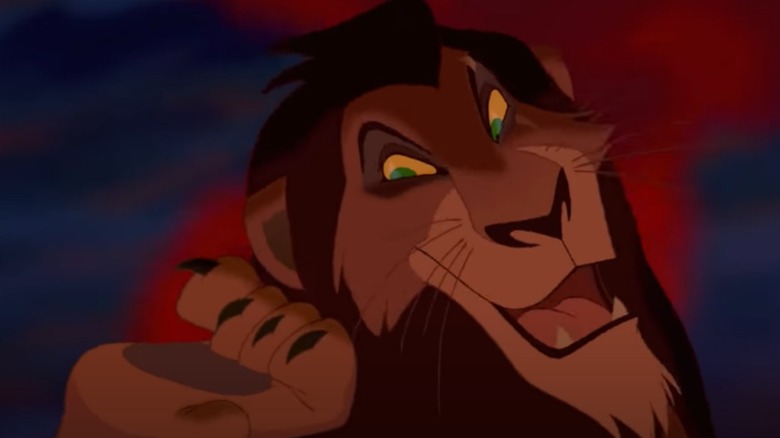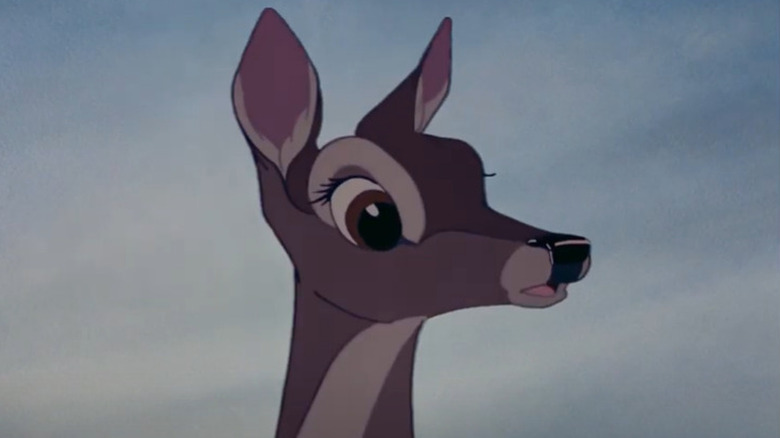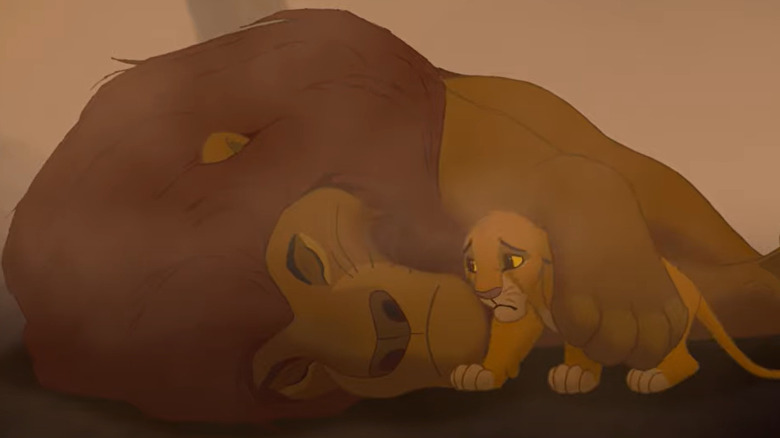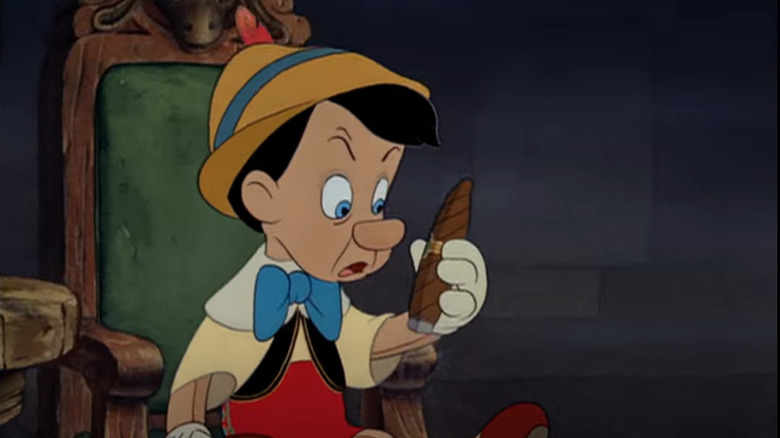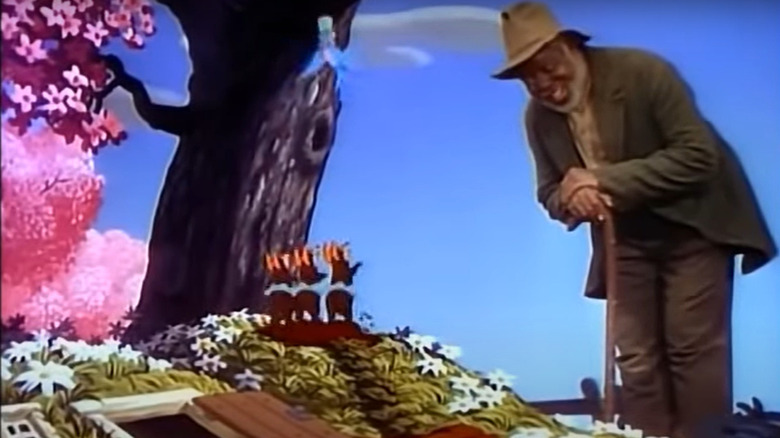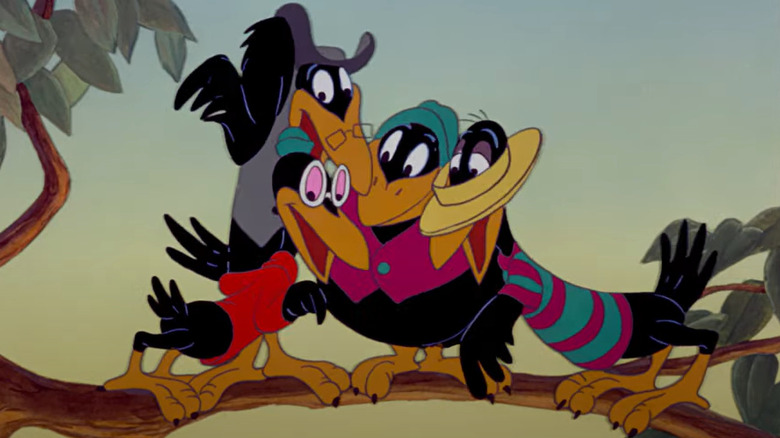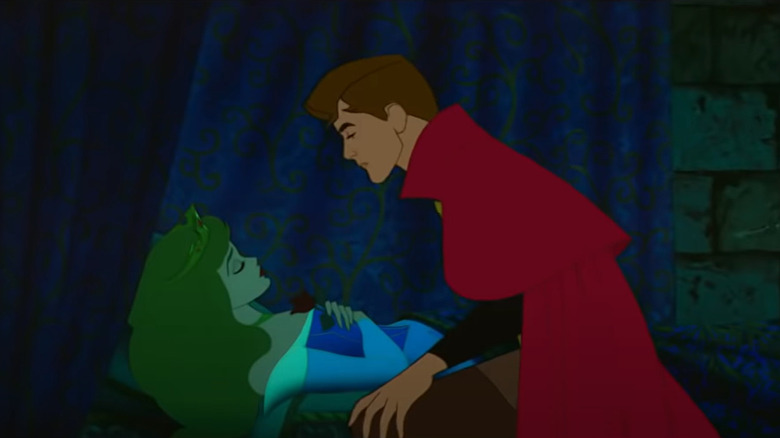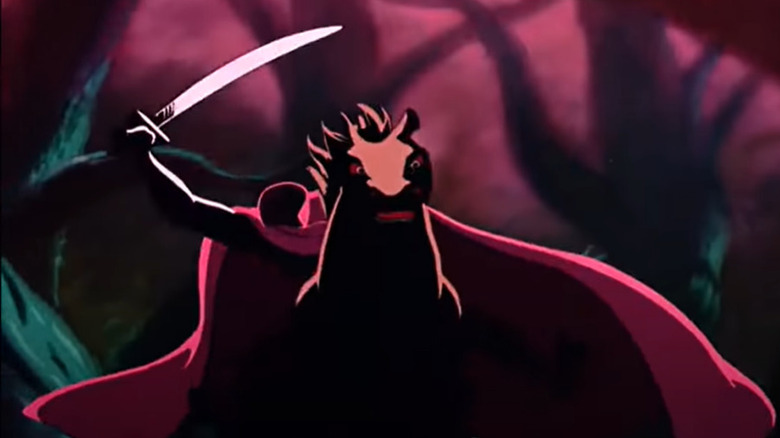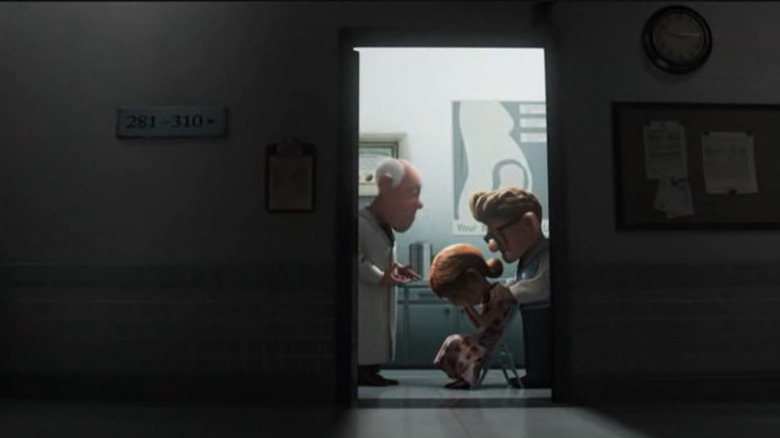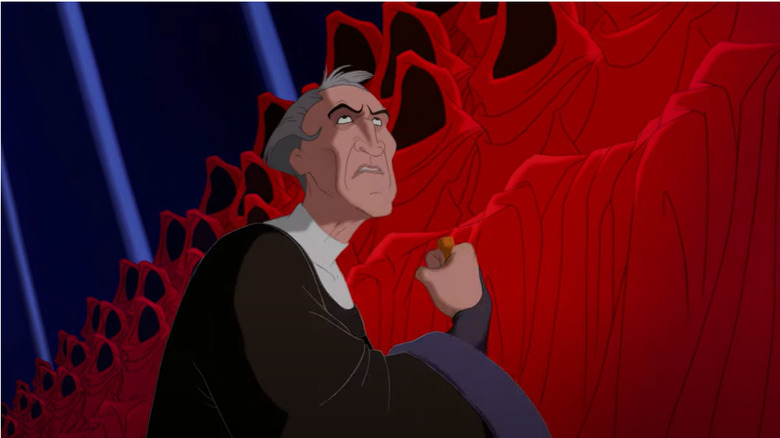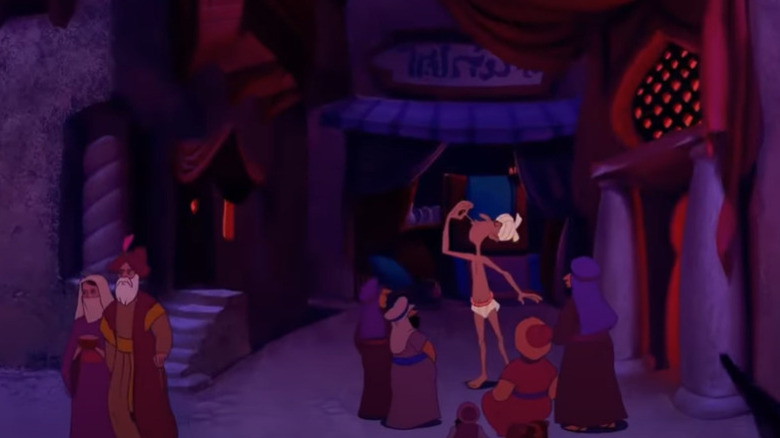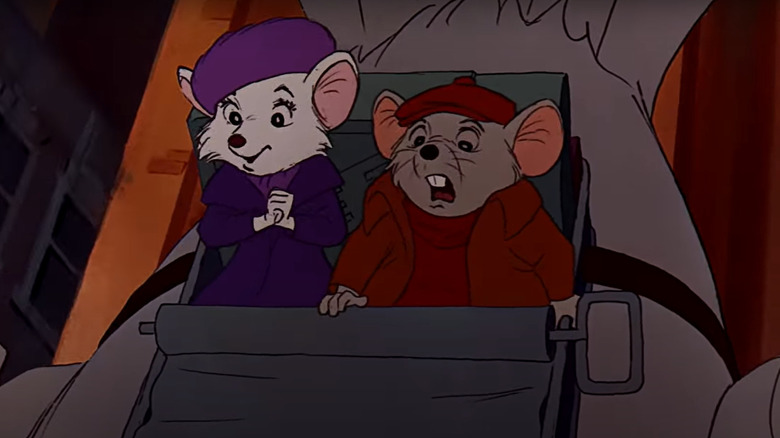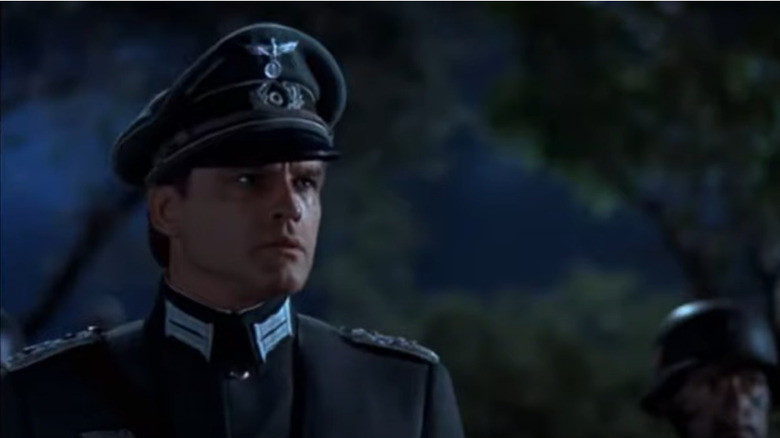Dark Parts Of Disney Movies That Went Over Your Head As A Kid
Few brands evoke the warm and family-friendly feelings of childhood than Disney. For almost a century, Disney delighted countless kids around the world with innumerable films, TV shows, toys, and even theme parks. Wonder, whimsy, and imagination (along with the occasional useful life lesson) are just a few hallmarks of the Disney movies so many of us watched in our youth.
However, as an adult, have you ever gone back to watch your favorite Disney movie when you were a child? If you have, you may have been surprised at how dark these films can be, containing scenes whose mature subject matter you — like most of us at that same age — completely failed to notice. Death, racism, non-consensual kissing, Nazis, and all sorts of other surprisingly grim elements have found their way into classic Disney movies that were ostensibly marketed to families. And while it may be easy to assume that all of these offending films were from decades ago, from eras that had more unenlightened ideas of what should be shown to children, there have been more recent Disney movies that have wandered into pretty bleak territory.
Bambi
Based on Felix Salten's 1923 novel "Bambi, a Life in the Woods," the Disney adaptation follows the eponymous newly born fawn who's destined to become the protector of the forest and its inhabitants. As Bambi grows up, he develops a close relationship with his mother and eventually learns how to prance and speak with his rabbit friend Thumper. His other friends include a skunk he refers to as "Flower" and the pretty female fawn Faline. Bambi spends much of his time exploring the woods with his furry friends without a care in the world.
So how does this adorable little animated film take a dark turn? Well, one day the one creature that all of the animals in the forest fear -– "Man" — arrives to hunt them, and Bambi's mother is shot and killed. Considering his father is occupied by his role as the Great Prince, Bambi is essentially turned into an orphan. It's a surprisingly heart-wrenching scene in an otherwise uplifting film that packs a real emotional wallop despite being mostly offscreen. Surprisingly, the death of Bambi's mother was actually going to be shown on screen but was presumably considered too dark for audiences. Honestly, doesn't leaving it to our imaginations make it worse, though?
The Lion King
Simba, the newborn son of Pride Land royalty King Mufasa and Queen Sarabi, is raised to someday take over the throne and rule over the region. However, Mufasa's bitter brother Scar wants the position for himself and has been hatching a scheme to kill Mufasa with the help of his three maniacal hyena stooges. Scar carries out this plan by provoking a herd of wildebeest into stampeding into a gorge where Simba and Mufasa are. Mufasa saves his young son from falling into the stampede, but Scar throws his brother into the raging horde and drives off Simba so that he can take the throne of Pride Rock for himself.
Again, this impactful death scene is mostly offscreen, but that does little to detract from how brutal it is; Mufasa is literally stomped to death by countless wildebeests. Part of what makes Mufasa's demise so powerful is the fact that it happens halfway into the film, meaning we get to spend plenty of time learning about and, ultimately, sympathizing with him. It was a risky move according to the film's co-director Rob Minkoff, who told Collider, "One of the things [Jon Favreau] said, which I found really fascinating, he said to me, 'If we made this movie for the first time today, the studio never would have let us kill Mufasa the way we did.' Because it's not in the first reel."
Pinocchio
Geppetto is a kindly toymaker living in a small Italian town in the 1800s who carves a wooden boy named Pinocchio with the wish that he become a real boy. His wish is partly granted; a Blue Fairy arrives and gives the wooden figure life, promising to turn him into a human if he proves himself worthy enough. Pinocchio is soon whisked away with his friend and "conscience" Jiminy Cricket by the conniving Honest John and Gideon and sent to Pleasure Island for a "vacation." Upon arrival, Pinocchio and other hoodlum boys engage in all sorts of underage debauchery as if they're training for roles in the "Hangover" films.
Child human trafficking, followed by kids drinking booze and smoking stogies, capping off with them turning into anthropomorphic donkeys against their will — there's so much wrong here that young audiences must've surely missed upon first viewing. Seriously, this whole sequence could easily be a mashup of D.A.R.E. and stranger danger PSAs, and a very effective one, too. Believe it or not, this scene wasn't just kept for the live-action remake — it was worsened. As noted in Decider, the donkey face is completely over the top, calling its teeth "Sonic-esque" and protruding, with the outlet arguing that at least the cartoon version was "sort of cute" and not striking horror into the heart of the movie's viewers. The more explicit nature of the live-action version of the scene is too shocking to go over anyone's head.
Song of the South
Set in Georgia during the Reconstruction Era, "Song of the South" focuses on the young Johnny who's staying at his grandmother's plantation with his mother while his father works his job as a newspaper editor in Atlanta. Johnny, upset by his father's leaving the family, runs away from home, only to run into the kindly Uncle Remus who shares with him the folktale, "Br'er Rabbit Earns a Dollar a Minute." The story is enough to convince Johnny to return back to the plantation, where he gets into all kinds of trouble with his new friends Ginny Favers and Toby.
Because of its offensive depiction of Black people, "Song of the South" is easily Disney's most infamous film and has yet to receive an official home video release in the United States. The whole movie is enough to deserve a whole article, but let's focus on the scene featuring its most famous song, "Zip A Dee Doo Dah." In it, Uncle Remus sings the catchy tune in a vivid animated world as if nothing is wrong. While the film takes place after the Civil War and slavery's abolition, the film and that scene in particular completely ignores how rough life still was for Black people. For the tiny few of you who managed to see it as a youngster, you undoubtedly missed just how egregious its recreation of the Reconstruction Era really was.
Dumbo
Dumbo is a sweet young elephant whose major flaw is his overly big ears, making him the clumsiest performer of the traveling circus he and his mother are a part of. His mother is extremely protective of him and does whatever she can to fend off whoever picks on her son. However, she gets into trouble with the circus' ringmaster and is separated from Dumbo, leaving him to fend for himself. But with the help of a friendly mouse and a murder of rowdy crows, he's able to find his true gift and become the star of the circus.
In many ways, "Dumbo" is one of Disney's most heartwarming stories, and for good reason; beautiful animation and memorable songs combine to deliver a sweet story about finding your inner strength. But remember those crows? Watching that scene where they help Dumbo to fly now, it's obvious that they were incredibly insensitive depictions of southern Black people. Making the scene even more uncomfortable is the fact that the over-the-top accents were provided by white voice actors. Luckily, the crows' appearances are mostly confined to one sequence. Still, while the film can be seen on Disney+, it does come with a disclaimer about their inclusion.
Sleeping Beauty
King Stefan and Queen Leah are proud to welcome their daughter, Princess Aurora, into the world, and soon arrange for her to marry the son of King Hubert, Prince Phillip, when she's grown. Three good fairies — Flora, Fauna, and Merryweather — bless her with stunning gifts, but the fourth fairy, the evil Maleficent, puts a curse on her wherein, when she turns 16, she will prick her finger on a spinning wheel and cease to live. Luckily, the three good fairies manage to alter the curse so that she won't die but instead fall into a deep sleep, with the kiss from her one true love being the only thing that can wake her.
Of course, in true fairytale fashion, all of these events come to pass as prophesied. Prince Phillip slays Maleficent in dragon form and arrives to kiss Princess Aurora to awaken her and live happily ever after. How romantic, right? But any adult who's paid attention to the news in recent years knows that a man kissing a sleeping woman is anything but romantic. Add in that Aurora was betrothed to Phillip when she was a baby, and you realize that she hasn't had any say in the matter. Disney at least tried to lighten up on the troublesome aspects by having the two meet and fall for each other before that meddlesome kiss. Still, it's an awkward remnant from a source material that has the princess impregnated by her "one true love" while asleep. Ew.
The Adventures of Ichabod and Mr. Toad
"The Legend of Sleepy Hollow" segment of the film follows eccentric schoolteacher Ichabod Crane as he arrives in the fabled town and attracts the attention of its women. However, he only has eyes for the stunning Katrina van Tassel, who unfortunately is in a relationship with Brom Bones, Sleepy Hollow's toughest fellow. The two men compete for Katrina's heart, much to her delight, with Ichabod beating Brom at every turn. At a Halloween celebration, Brom ascertains Ichabod's biggest fear, that of ghost stories, prompting him to recount the tale of the Headless Horseman. Brom successfully spooks Ichabod with the frightening legend, but Ichabod soon learns that it may be more than an old wives' tale.
This segment made an odd pairing with the whimsical "Wind in the Willows" story that preceded it, and it's all because of the actual appearance of the Headless Horseman. The sequence, despite some patches of humor, is quite scary, building suspense with the beautifully rendered animation, chilling sound effects, and the disturbing design of the Headless Horseman who chases Ichabod. While some in town believe that Ichabod ran out of town and settled down far away, it's heavily implied that the schoolmaster met his maker at the hands of a ghoulish entity. Even the lead-up is a nail-biter, with Dread Central stating that the segment is terrifying for a kid's movie but a fine example of how, even in a Disney cartoon, tension and fear can expertly be interwoven.
Up
Carl Fredricksen is a young boy who looks up to famed explorer Charles Muntz. One day, he meets the adventurous Ellie, and the two become closer over the years in a charmingly sweet montage that takes place over decades. Carl and Ellie get married, move into a house that they fix up together, and while away the hours watching the passing clouds. Over the years, they save up money for a trip to Paradise Falls but must contend with various mishaps that set them back financially. Carl decides to surprise Ellie with tickets for their dream vacation, but by this time they're both in old age, and Ellie dies before they could embark on that trip.
Ellie's untimely passing is obviously heartbreaking, but there's another tragic little detail that many of us probably didn't notice when we were young, and that is the miscarriage the happy couple suffered while trying to build the perfect family life together. This revelation is given to us in only one shot — that of Carl consoling a crying Ellie in the doctor's office — and without dialogue, but it's one that many parents would instantly understand. Peter Docter, who directed "Up," told Yahoo! that there were some reservations about including that moment, saying "... some people felt like we were going a little too far ... We got some notes from people in the studio that thought that the moment where they couldn't have kids was going too far."
The Hunchback of Notre Dame
Quasimodo is the hunchbacked inhabitant of Notre Dame's bell tower, cut off from the rest of the world because of his abnormal appearance. He was placed there as a baby when his mother was killed by the brutal Judge Claude Frollo, who plans to exterminate Paris' Romani population. One of the Romani, a beautiful woman named Esmeralda, rescues Quasimodo, a rare instance of kindness from an outsider. The two become close friends, along with Captain Phoebus, who has defected from Frollo's guard. Quasimodo helps Esmeralda escape, but not before she gives him a map that leads to a Roma haven. Meanwhile, Frollo gets ready to begin his attack on the Romani people.
As if this G-rated film wasn't mature enough, there's a sequence that sees Frollo sing a song about how his lust for Esmeralda conflicts with his duty and his religion, putting his soul at risk of eternal damnation. Yup, that actually takes place in a Disney movie.
The song is accompanied by some appropriately grim imagery, including towering flames and a congregation of faceless, red-robed figures that gets awfully close to horror movie territory. The film's co-director Kirk Wise told The New York Times that, while there was some trepidation around exploring Frollo's sexual fascination with Esmeralda, it was too important to exclude, saying "We knew that was going to be a really delicate topic. But we also knew we had to tell that story, because it's key to the central love rectangle."
Aladdin
Inspired by "Aladdin and the Magic Lamp" from "One Thousand and One Nights," "Aladdin" tells the story of the eponymous dashing vagabond as he's manipulated by the power-hungry Jafar into retrieving a mystical lamp for him from the Cave of Wonders. However, realizing Jafar's deception, Aladdin keeps the lamp for himself, releasing a genie who promises to grant him three wishes. Aladdin uses the first wish to become a prince in an attempt to win the heart of Princess Jasmine. But Jafar is determined to become sultan and will stop at nothing to steal back the magic lamp and marry Jasmine himself.
"Aladdin" is part of Disney's late-1980s and 1990s animated renaissance that saw the company return to the magic that characterized its 1940s and 1950s heyday. Of course, as dazzling as the film is, it wasn't without some controversy surrounding a particular scene that young audiences probably missed. The opening musical number featured the following lyrics: "Oh, I come from a land / From a faraway place / Where the caravan camels roam. Where they cut off your ear / If they don't like your face / It's barbaric, but hey, it's home." The lines didn't sit well with the American-Arab Anti-Discrimination Committee, which believed that it portrayed Arabs in a negative manner. Subsequent releases of the film featured lyrics that removed the more insensitive elements of the original song.
The Rescuers
Miss Bianca and Bernard are intelligent mice and members of the Rescue Aid Society. The two are assigned a case to look for the young orphan girl Penny who's been kidnapped. After paying Penny's orphanage a visit, Miss Bianca and Bernard learn of a suspicious woman, Madame Medusa, and her previous attempts to whisk Penny away. The miniscule detectives track down Medusa and uncover her plan to acquire the world's largest diamond with her partner, Mr. Snoops, and that they are indeed Penny's kidnappers. Upon discovering Penny's whereabouts, Miss Bianca and Bernard team up with the albatross Orville and the dragonfly Evinrude to foil Medusa's plan and rescue the orphan.
While "The Rescuers" may be overshadowed by some of Disney's other films, it's still a strong entry in their impressive animated canon. But if you saw the film as a child before 1999, you may have witnessed something that definitely was not meant for your innocent eyes. That something is a two-frame depiction of a nude woman in the background of the scene wherein Miss Bianca and Bernard are flying through the city on Orville's back. Granted, because it was only two frames in the background, it's highly likely that even the most eagle-eyed viewers wouldn't have spotted the offending image that someone snuck into the film without pausing it. Good luck if you want to jog your memory, though — Disney recalled 3.4 million copies of the film and censored all future releases of the film.
Bedknobs and Broomsticks
Set during World War II in England, three young siblings are sent away from their home in London during an attack to be looked after by Miss Eglantine Price. Unhappy with their new home, the children decide to return to London but change their minds when they discover that Miss Price is an aspiring witch, hoping to use her powers in the fight against the Nazis. She offers to transport the children back to their original home via an enchanted bed, but she needs the final part of the spell before she can do that. And so, Miss Price and the children embark on a whimsical adventure featuring magical lands, talking animals, and animated household objects. Oh, and Nazis.
The movie barely mentions World War II for most of its duration, focusing on the lighthearted elements. But there's a jarring reminder of the Third Reich when a platoon of Nazi soldiers attempts an invasion of Miss Price's home, forcing her to bring some ancient relics to life with an invisible army to fight off the goose steppers. The Nazis' atrocities aren't mentioned in "Bedknobs and Broomsticks," but older audiences are well aware, adding a tinge of grimness to an otherwise silly fantasy movie. As Roger Ebert exclaimed in his review, "But what are Nazis doing in this picture, anyway? And why is it necessary for a character to exclaim, toward the end of the movie: 'We have driven the Hun into the sea?' What do kids know from Huns anyway?"
